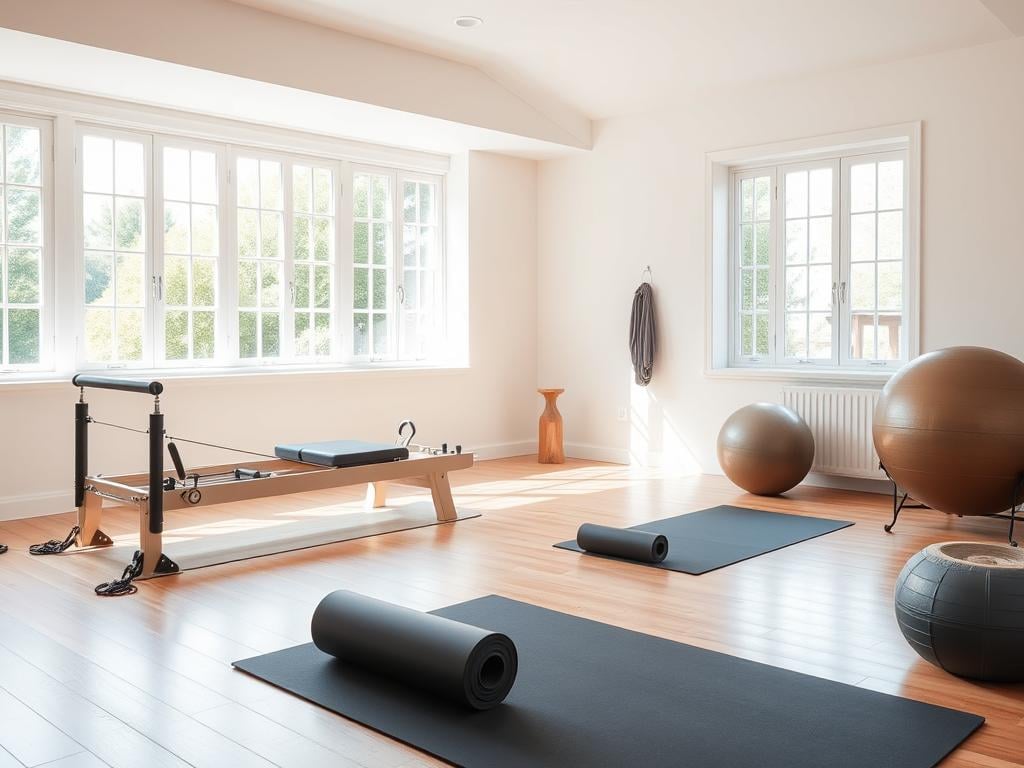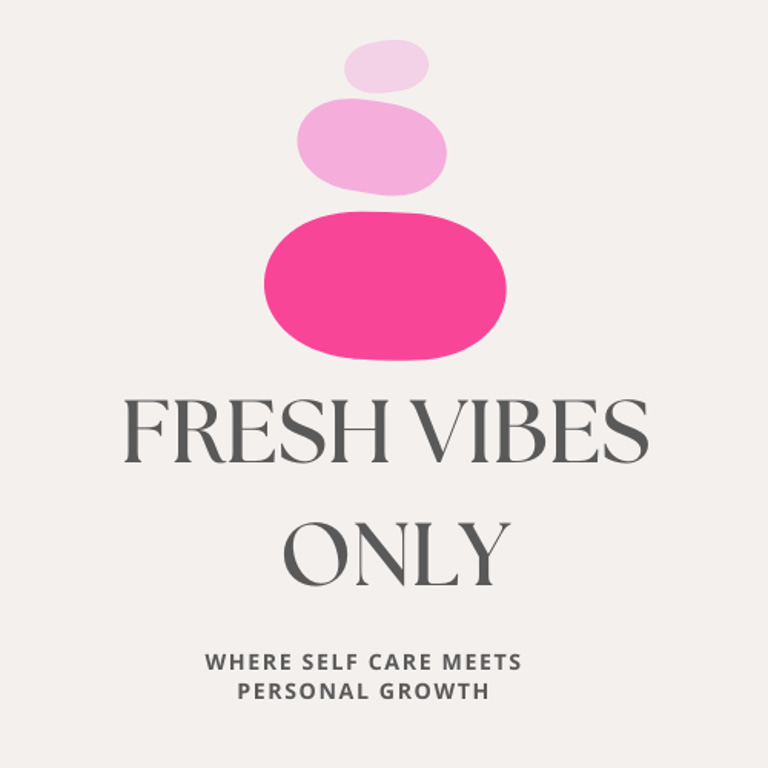Pilates at Home
Transform Your Space: Practicing Pilates at Home Pilates at home is an empowering way to enhance your fitness journey without the need for a gym membership. With its focus on core strength, flexibility, and mindful movement, Pilates can be easily integrated into your daily routine. All you need is a mat and a bit of space to get started! Begin by setting a dedicated area in your home where you can practice consistently. This space should be free from distractions and provide enough room for movements like stretches and leg lifts. Start with online classes or tutorials that cater to beginners, gradually progressing to more advanced sessions as you build confidence and strength.
Calen Rey
10/3/20248 min read
My post content

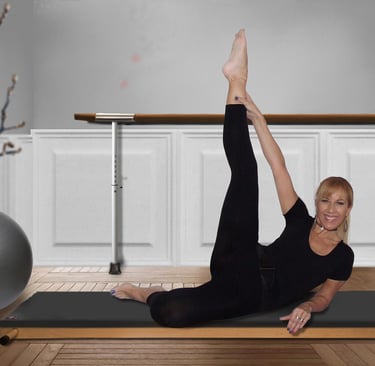
This post may contain affiliate links for which
I may receive a commission from purchases
made through the links
Discover the transformative power of Pilates right in the comfort of your own home. This versatile mind-body exercise offers a range of benefits. It improves strength, flexibility, focus, and stress relief. Whether you're a Pilates enthusiast or new to the practice, exploring Pilates at home can unlock your full potential with unparalleled convenience.
This comprehensive guide will introduce you to the core principles of Pilates. It will equip you with the necessary tools and provide step-by-step routines for all levels. Embark on a journey of self-discovery and physical transformation. All while enjoying the comfort and flexibility of a Pilates practice tailored to your home environment..
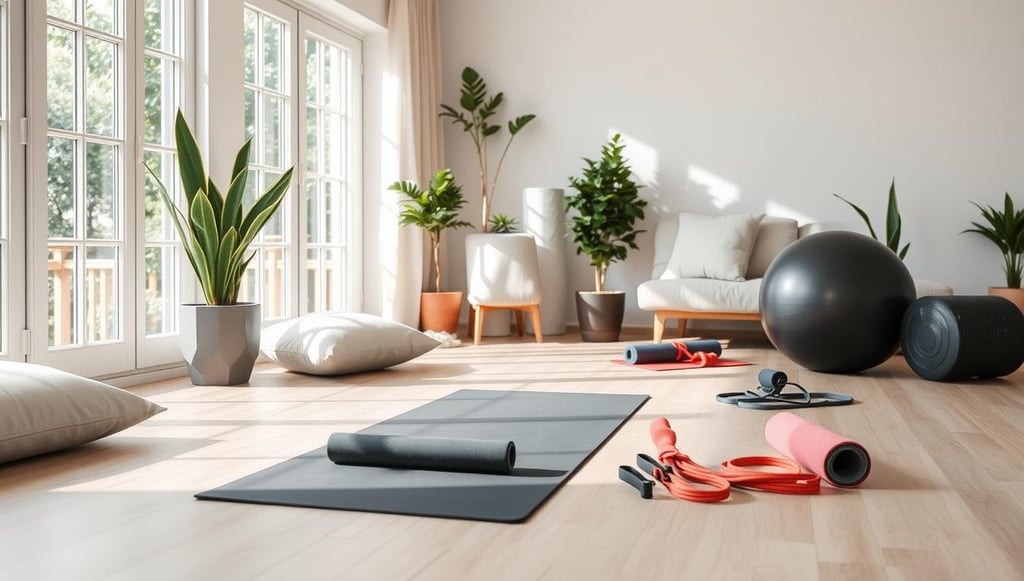

Essential Equipment for Your Home Pilates Studio
Starting a Pilates practice at home requires the right gear. While you can do Pilates with little equipment, the right tools can make a big difference. They help you reach your fitness goals more effectively.
From Mats to Resistance Bands: Building Your Pilates Arsenal
A good Pilates mat is key for your home studio. It offers cushioning and stability for your workouts. Pilates resistance bands add challenge and variety, targeting specific muscles and boosting strength. Pilates props, like yoga blocks or small stability balls, help modify and deepen your movements. This makes your workouts more comprehensive and tailored to you.
Invest in a durable Pilates mat for a comfortable and stable base
Incorporate Pilates resistance bands to add resistance and challenge
Utilize Pilates props like yoga blocks or stability balls for increased versatility
Foam rollers really help for relaxing and help with deep tissue and muscle recovery
Choosing the right Pilates equipment for home and Pilates accessories is crucial. It lets you build a versatile Pilates arsenal. This arsenal allows you to try a variety of exercises and grow in your practice with confidence.
What is Pilates?
Pilates is a workout system that strengthens the core and boosts flexibility. It was created by Joseph Pilates in the early 1900s. This practice combines precise movements with mental focus, linking the mind and body.
Exploring the Core Principles of This Mind-Body Exercise
The core of Pilates includes six key principles: Concentration, Control, Centering, Breath, Flow, and Precision. These principles help users connect their mind and body. They also build a strong, balanced body and increase awareness of their movements.
Concentration: Pilates demands intense focus and mental effort for each movement.
Control: It focuses on controlled, mindful actions, not momentum or external forces.
Centering: The core muscles are the base of Pilates, aiming for a strong, stable center.
Breath: Proper breathing is key, helping to oxygenate and connect the mind and body.
Flow: Movements are smooth and fluid, creating a continuous motion.
Precision: Quality over quantity is emphasized, focusing on perfect form.
By following these principles, Pilates users gain a deeper understanding. They learn about Pilates history, benefits, and movements that change their bodies and minds.

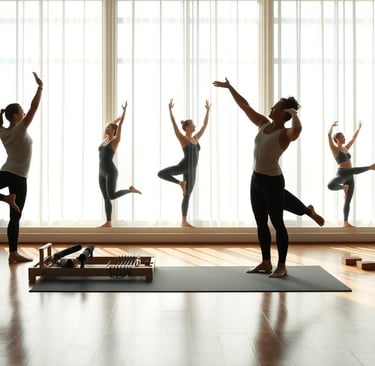
Pilates is the complete coordination of body, mind, and spirit." - Joseph Pilates
Benefits of Practicing Pilates at Home
Pilates is a holistic exercise that fits easily into daily life. By doing Pilates at home, you gain many benefits for your well-being. It helps with Pilates for fitness, Pilates for stress relief, Pilates for flexibility, and Pilates for posture. The convenience and flexibility of home Pilates can change your life.
One big plus of Pilates at home is strengthening your core. Pilates works on your abdominal, back, and pelvic muscles. These muscles are key for good posture, balance, and body control. Doing Pilates at home helps build a strong core, improving your physical skills and lowering injury risk.
Pilates at home also boosts your Pilates for flexibility and mobility. It includes stretching and movements that increase flexibility and joint mobility. Regular practice leads to more flexible muscles, better joint function, and a more balanced body.
"Pilates has been a game-changer for me. Since I started practicing at home, I've noticed significant improvements in my Pilates for posture and overall body awareness. It's a truly holistic approach to fitness."
The mental and emotional benefits of Pilates at home are huge. Pilates focuses on the mind-body connection, helping you focus on breath, movement, and mental state. Doing Pilates at home reduces stress and anxiety, improves mental clarity, and boosts overall well-being.
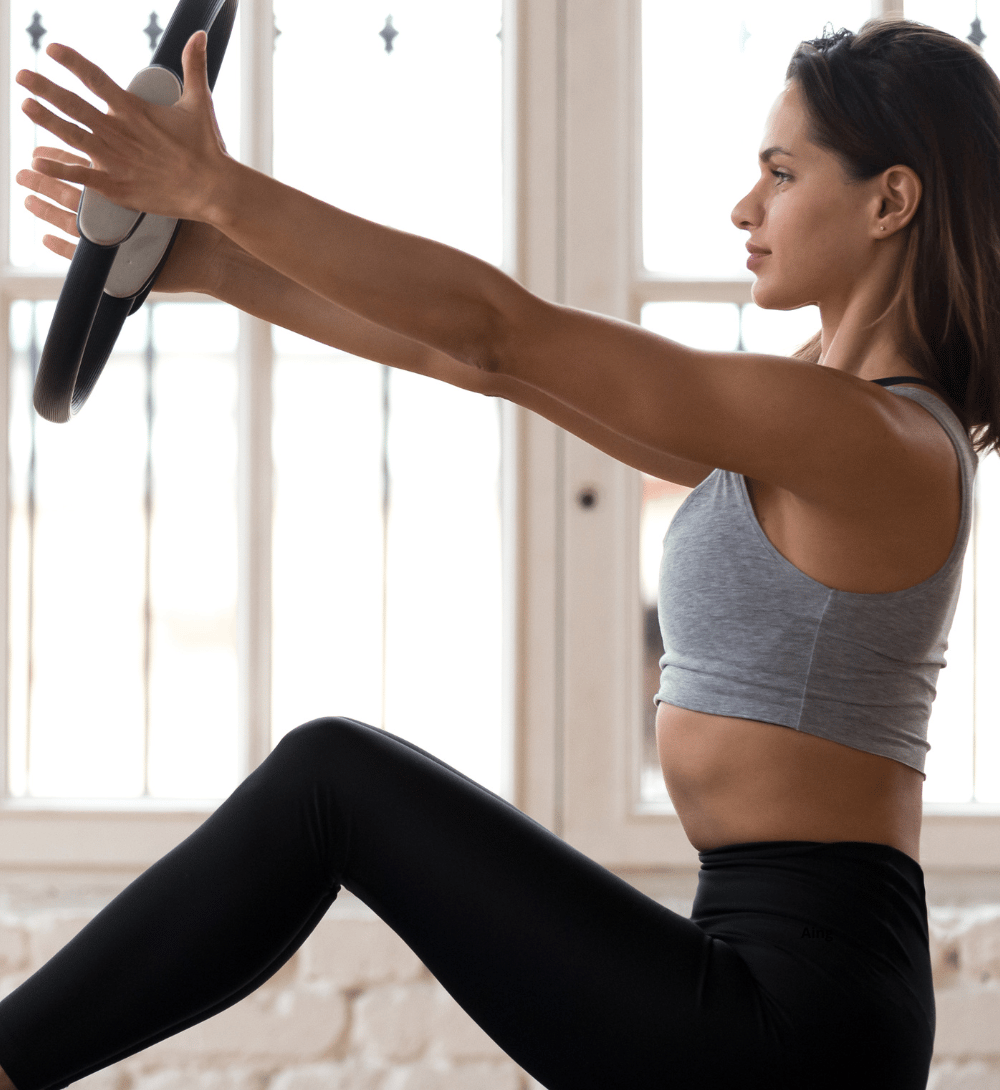

Whether you want to boost your Pilates for fitness, find Pilates for stress relief, or improve your physical and mental health, Pilates at home offers many benefits. Adding Pilates to your daily routine can lead to a stronger, more balanced, and resilient you.
Setting Up Your Home Pilates Space
Creating a Pilates home setup in your home can really boost your practice. Think about the Pilates space requirements, lighting, and the feel of the room. Pick a spot that's quiet and has enough room to move around.
Make sure the Pilates room design is bright, either from natural light or special lights. This will help you stay calm and focused. Add things that motivate you, like inspiring pictures or colors, to make your space special.
Having a dedicated Pilates area at home can make your routine more enjoyable. With the right Pilates home setup, you can enjoy all the benefits of Pilates and make it a big part of your life.


Pilates at Home for Beginners
Starting Pilates at home is a great way for beginners to learn. It helps you build a strong foundation and gain confidence. By learning the basics and focusing on form, you'll enjoy a fulfilling Pilates journey.
Step-by-Step Guide to Getting Started
Begin with simple exercises like the Hundred, Leg Circles, and Spine Stretch Forward. These Pilates beginner routines improve strength, flexibility, and control. They are key to Pilates.
Learn the basics like the Hundred, Leg Circles, and Spine Stretch Forward.
Pay attention to form and technique for a safe practice.
As you get better, try more challenging Pilates beginner modifications.
Always listen to your body to avoid injuries.
Practice regularly to see the benefits of Pilates for beginners.
With time and effort, you'll connect your mind and body through Pilates. Remember, the journey is just as valuable as the end result. Enjoy the changes Pilates at home for beginners brings to your life.
"The Pilates method teaches you to be in control of your body and not at its mercy." - Joseph Pilates
Intermediate Pilates Routines for Home Practice
As you get better at Pilates, it's time to try harder Pilates intermediate routines at home. These workouts are tougher and build on what you learned in beginner classes. They challenge your body and mind more.
Pilates intermediate exercises often use props like resistance bands and stability balls. These tools make your workouts more intense. They help strengthen your core, improve balance, and enhance body control.
You'll do exercises like the Roll-Up, One-Leg Circle, and Teaser. These need more skill and coordination. They require smooth movements and focus on your body's alignment.
Doing these Pilates home workouts regularly will change your strength, flexibility, and control. Your hard work will show as you get better and reach new fitness levels.
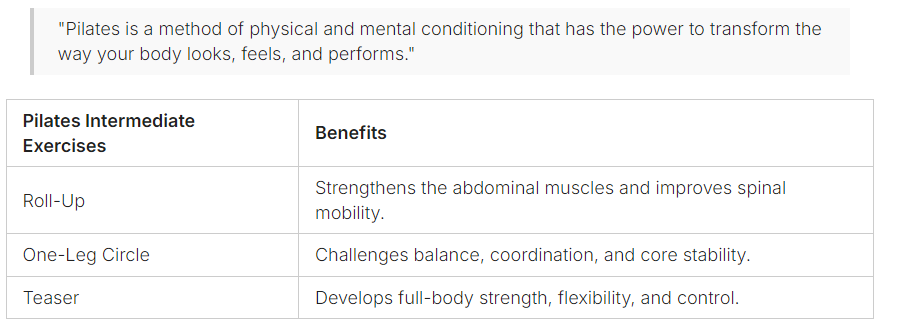

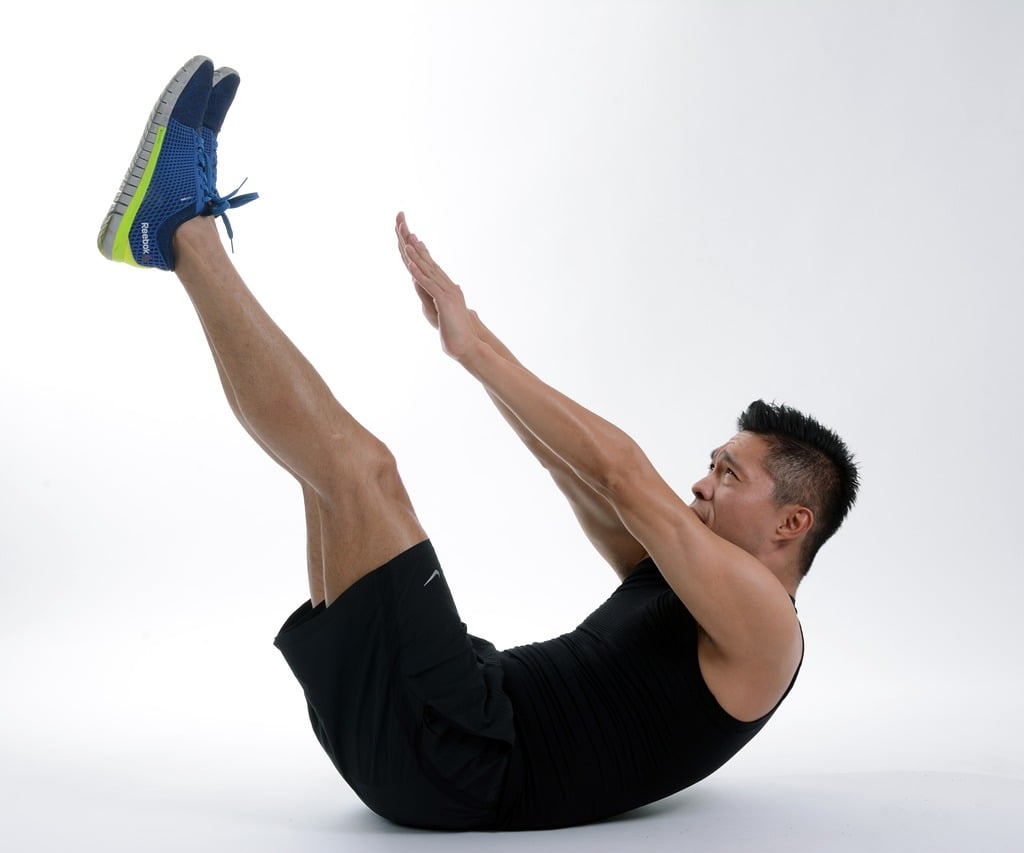

Advanced Pilates Workouts for the Seasoned Practitioner
For those who love Pilates, your home can be the best place to try new, tough exercises. These workouts include complex moves, more resistance, and a focus on control and precision.
Challenging Exercises to Take Your Practice to the Next Level
You'll do exercises like the Double-Leg Kick, the Corkscrew, and the Dive Bomber. These need great core strength, balance, and flexibility. Adding these Pilates workouts to your routine will help you grow stronger, more agile, and in control of your body.
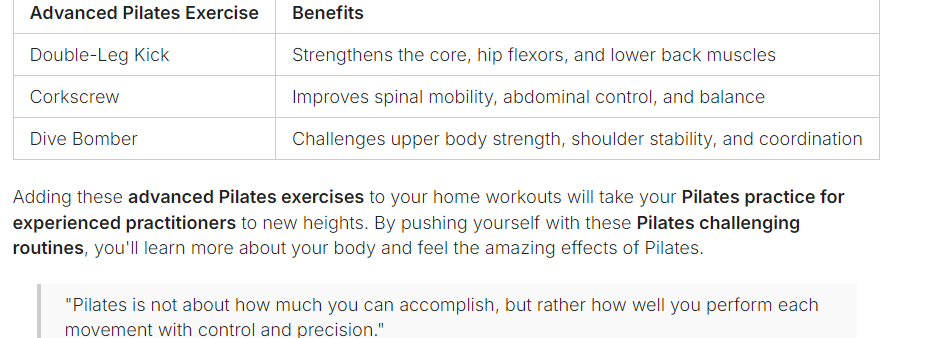

Pilates at Home for Specific Goals
Practicing Pilates at home lets you focus on your fitness goals. You can work on building strength, improving flexibility, or boosting your heart health. Pilates is flexible, so you can adjust the exercises to meet your needs.
Tailoring Your Routine for Strength, Flexibility, and More
Find Pilates routines that match your goals, like strengthening your core or toning your legs. Having a home studio makes it easy to fit Pilates into your life. It can change your body and improve your health.
Whether you want to get stronger, more flexible, or achieve other goals like losing weight or rehabbing an injury, Pilates can help. Its flexibility makes it a great tool for reaching your fitness dreams.
FAQ
What is Pilates?
Pilates is a workout system that strengthens the core and boosts flexibility. It was created by Joseph Pilates in the early 1900s. This practice focuses on controlled movements that connect the mind and body.
What are the core principles of Pilates?
Pilates is based on six key principles: Concentration, Control, Centering, Breath, Flow, and Precision. These principles help you connect with your body, build strength, and improve your body awareness.
What are the benefits of practicing Pilates at home?
Doing Pilates at home has many benefits. It can make your core stronger, improve flexibility, and enhance posture. It also tones muscles and reduces stress.
What essential equipment do I need for my home Pilates studio?
You'll need a good Pilates mat, resistance bands, and yoga blocks for your home studio. These tools add variety and challenge to your workouts.
How do I set up an effective Pilates space in my home?
Choose a quiet area with enough space for movement. Good lighting is important for a calm environment. This setup helps you focus and enjoy your workouts.
How do I start practicing Pilates as a beginner at home?
Start by learning the basics of Pilates at home. Focus on proper form and try simple exercises like the Hundred and Leg Circles. This will help you build a strong foundation.
What intermediate Pilates routines can I explore at home?
Once you're comfortable with the basics, try more challenging routines. Use resistance bands and stability balls to increase the intensity of your workouts.
What advanced Pilates workouts can I do at home?
If you're experienced, home is a great place to try advanced Pilates. These workouts include complex movements and higher resistance levels.
How can I tailor my Pilates routine to achieve specific goals?
The beauty of Pilates at home is you can customize your workouts. Whether you want to get stronger, more flexible, or improve your heart health, Pilates can help.
